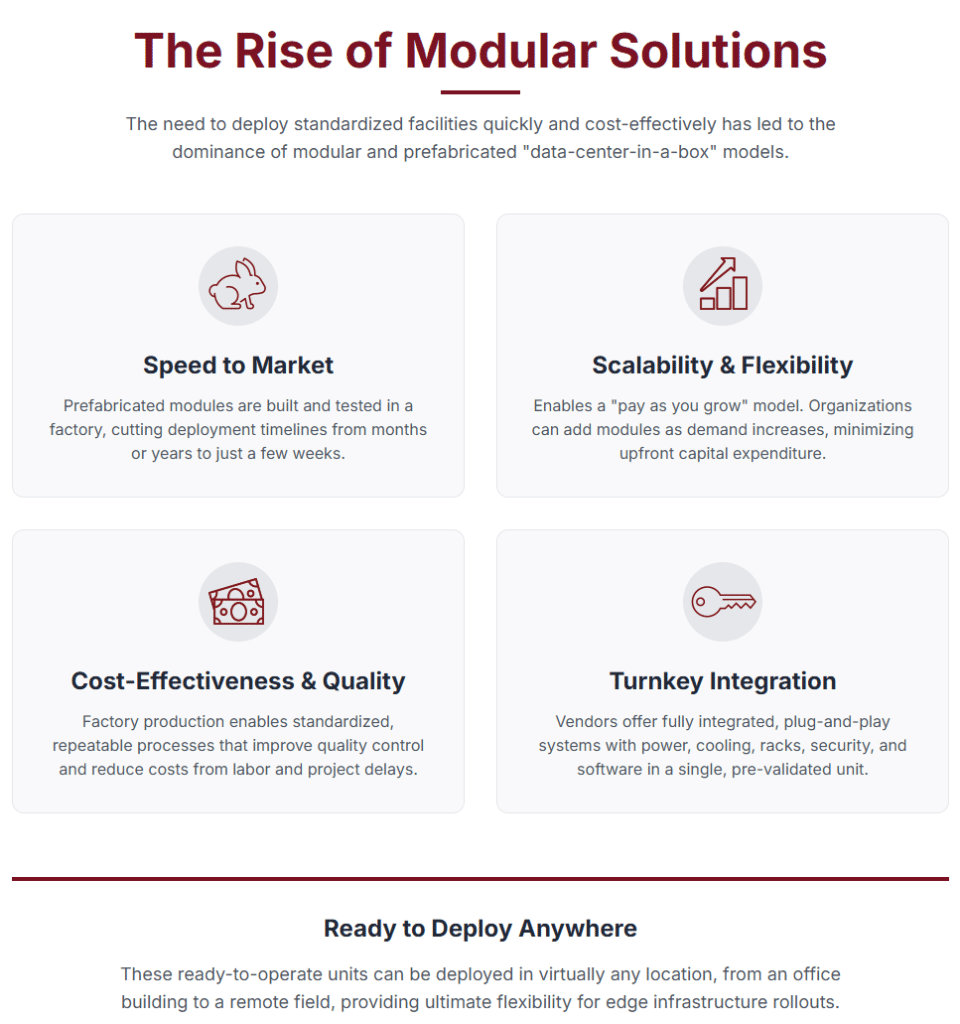The Rise of Modular Edge Data Centers
Published on July 11, 2025,
by
As the demand for edge computing continues to surge, the traditional approach to building data centers, brick by brick, is proving too slow, too expensive, and too inflexible. Enter modular edge data centers, a game-changing solution that’s reshaping how infrastructure is deployed at the edge.
These prefabricated, factory-built systems are designed for rapid deployment, scalability, and cost-efficiency. Often referred to as “data centers in a box,” modular solutions are becoming the go-to choice for organizations that need to roll out hundreds or even thousands of edge sites quickly and reliably.
Let’s explore why modular edge data centers are gaining traction and how they’re solving some of the biggest challenges in edge infrastructure.

Speed to Market: From Months to Weeks
One of the most compelling advantages of modular edge data centers is their speed of deployment. Traditional data center construction can take many months—or even years—due to complex site preparation, permitting, and on-site labor.
In contrast, modular systems are built and tested in controlled factory environments. This off-site construction dramatically reduces on-site work, allowing organizations to deploy fully operational edge facilities in a matter of weeks. For businesses racing to support latency-sensitive applications like autonomous vehicles, smart cities, and real-time analytics, this speed is a game-changer.
Faster deployment means faster time to value—and a significant competitive edge.
Scalability and Flexibility on Demand
Another key benefit of modular edge data centers is their inherent scalability. These systems are designed to grow with your needs. Organizations can start small—deploying only the capacity they need today—and scale up incrementally as demand increases.
This “pay-as-you-grow” model minimizes upfront capital expenditures and reduces the risk of overbuilding. It also supports just-in-time capacity planning, which is especially valuable in dynamic environments where workloads can shift rapidly.
Whether you're expanding into a new region or responding to a sudden spike in demand, modular solutions offer the flexibility to adapt quickly and efficiently.
Cost-Effectiveness and Quality Control
Cost is always a factor in infrastructure decisions, and modular edge data centers deliver significant savings. Factory-based production allows for standardized, repeatable processes that reduce labor costs, minimize waste, and improve quality control.
By avoiding many of the delays and uncertainties associated with on-site construction, organizations can better manage budgets and timelines. Additionally, the ability to replicate proven designs across multiple sites ensures consistency and reliability—two critical factors for edge deployments.
In short, modular solutions offer a smarter, more predictable path to edge infrastructure.
Turnkey Integration: Plug-and-Play Simplicity
Today’s modular edge data centers are more than just steel boxes—they’re fully integrated systems that include everything needed to go live. Leading vendors now offer turnkey solutions that combine:
- Power and cooling systems
- IT racks and cabling
- Fire suppression and physical security
- Environmental monitoring and management software
These pre-validated, plug-and-play units can be deployed in a wide range of environments—from office buildings and warehouses to remote oil fields and cell towers. This versatility makes them ideal for industries like telecom, healthcare, manufacturing, and energy, where edge computing is becoming mission critical.
Supporting the Edge Revolution
The rise of modular edge data centers is not just a trend—it’s a response to the evolving needs of the digital world. As more applications require ultra-low latency, localized processing, and real-time responsiveness, the edge is becoming the new frontier of IT infrastructure.
Modular solutions provide the speed, scalability, and reliability needed to meet these demands. They also align with broader industry shifts toward automation, sustainability, and distributed computing.
By embracing modular design, organizations can future-proof their infrastructure and stay ahead in an increasingly connected world.
Final Thoughts
The edge is growing fast—and so is the need for smarter, faster ways to deploy infrastructure. Modular edge data centers offer a compelling alternative to traditional construction, delivering rapid deployment, cost savings, and operational flexibility.
Whether you're a cloud provider, enterprise IT leader, or infrastructure strategist, now is the time to consider modular solutions as a core part of your edge strategy.
Streamlining Data Center Management: The Benefits of Integrated Data Center Management (IDCM)
